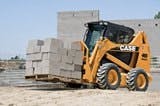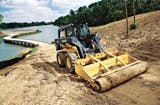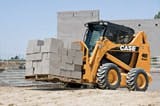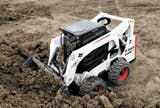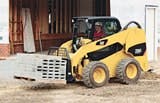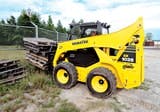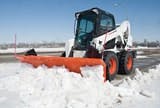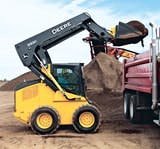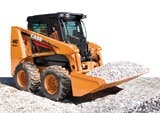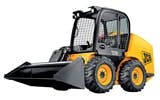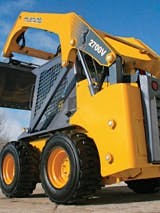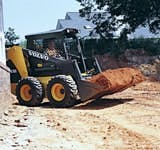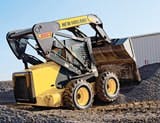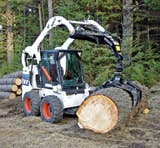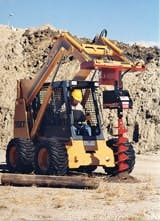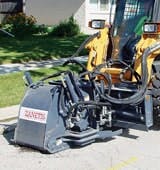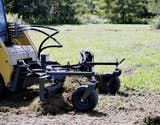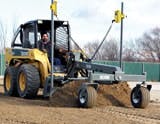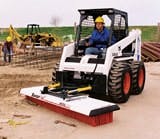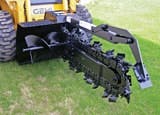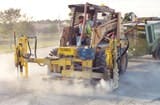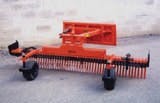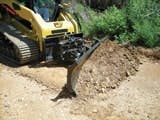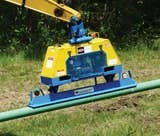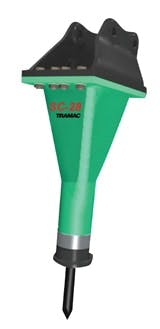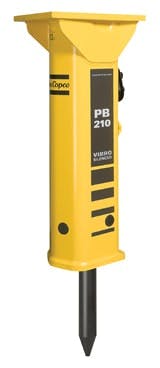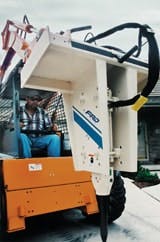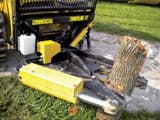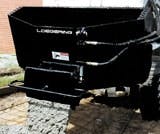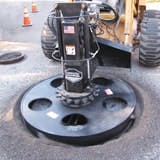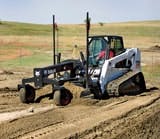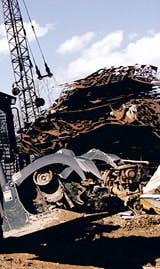The evolution of the large skid steer loader from utility- to production-caliber machine, as trumpeted in the Buying File profile of April 2008, is seemingly stepped up each and every time a manufacturer rolls out a new series since. It's not necessarily that the equipment type is physically getting bigger, because the established largest four individual models in the market remain as such. It's rather that manufacturers are quite frankly making their skid steers more efficient, more comfortable and more productive places in which to work. And the market seems willing to pay a price.
According to figures from EquipmentWatch.com, skid steers with a rated operating load or rated operating capacity of 2,201 pounds and up increased more than 22 percent in list price overall in the less than two years since the last Buying File coverage. At the dawning of 2010, a skid steer rated from 2,201 to 2,700 pounds sold for an average $43,327; a larger machine went for an average $46,355. Increases are undoubtedly in part attributable to mandated engine upgrades, but fancier operator digs offered up by manufacturers are in the mix, too.
The biggest of the big boys remain. According to figures compiled and verified by Spec Check, the behemoth 99-horsepower Gehl 7810E and brother Mustang 2109 top the field with rated operating loads of 3,850 pounds, followed by the Bobcat S330 at 3,300 pounds, and the Caterpillar 272C at 3,250 pounds (increasing to 3,480 pounds with optional counterweight).
Paternal industry brand Bobcat, already offering the K-Series S250, S300 and S330 vertical-lift-path skid steers rated at 2,500, 3,000 and 3,300 pounds, respectively, added a new vertical-lift model to the large-machine mix in 2009, as part of the all-new M-Series of compact loaders and excavators. The 2,690-pound-rated S650, following the lead of the similar-framed and -powered but lighter-lifting radius-lift-path S630 (rated at just under 2,200 pounds), incorporates a cab-forward design that comfortably sits the operator closer to the work area. A larger cab door with a lower threshold and 40-percent additional surface further enhances visibility, and makes it easier for operators to enter and exit. The new cab design, pressurized with a new one-piece seal, also features larger rear, top and side windows. New engine mounts improve isolation, decreasing vibration and sound levels, the latter cut by more than 60 percent, according to Bobcat. “I don't know why you'd want to get out of the machine,” says Rob Gilles, marketing manager.
Compared to models in Bobcat's pre-existing K-Series family, the 74.3-horsepower S630/S650 skid steers are about six inches shorter, but hydraulic horsepower has been increased more than 15 percent, says the company. Standard auxiliary flow on the debut M-Series machines is 23 gallons per minute; optional high flow reaches 30.5 gallons per minute. A new removable hose guide correctly routes hydraulic hoses, preventing hose wear and facilitating easier attachment changing. Other enhancements include 15- to 20-percent more tractive effort for pushing and digging power, 50-percent more lighting output for night work, and built-in holes for frame-mounted counterweights to increase lifting capacity. Selectable joystick controls are available.
Powered by Kubota V3307 direct-injection, turbocharged engines, the 74.3-horsepower skid steers and the corresponding T630 and T650 track loaders are only the beginning, says Bobcat. “The M-Series machines will be throughout the entire product line over the next two years,” says Mike Fitzgerald, loader product specialist.
Last fall, John Deere used the International Construction and Utility Equipment Exposition (ICUEE) in Louisville, Ky., as the backdrop to introduce the D-Series compact loaders, including the 326D, 328D and 332D vertical-lift skid steers rated at 2,600, 2,800 and 3,200 pounds, respectively. The previous 325, 328 and 332 models were rated at 2,500, 2,750 and 3,175 pounds, respectively, making the production capabilities of the new machines noteworthy, but that's only a fraction of the story, says John Deere.
“Customers have been asking us for more comfortable cabs similar to those found on larger pieces of Deere equipment, so we've introduced an all-new operating environment,” says Gregg Zupancic, product marketing manager for skid steers and compact track loaders. The positively pressurized D-Series cabs feature 24-percent more room, including six more inches of headroom, and are easier to get in and out of due to a larger door opening. “Even with all the changes, visibility to the work is better than the industry-leading visibility on the previous-generation 300 Series machines,” says Zupancic. A claimed 50-percent noise reduction in and around the cab comes from several sources beyond mere sound absorption, including a hydraulic fan drive, an auto idle feature, and the new electronically controlled John Deere 5030HT engines. A high-performance HVAC system includes eight adjustable airflow vents for additional comfort.
“Operators asked us why they can't get more 'big machine' features in skid steers, in addition to the bigger, more comfortable cab,” says Zupancic. “We think they're right, and that's why we've responded with items like the auto idle, an optional reversinghydraulic fan, and an innovative V-Plenum cooling system that provides significantly more cooling capacity and performance.” V-Plenum cooling, first introduced on Deere four-wheel-drive loaders, has coolers that are significantly larger and taller because they are side by side. They are protected from air-blown debris damage, since the fan is rearward of coolers; the fan is not blasting debris into coolers, but instead drawing or sucking air through coolers from the rear.
“Customers asked us if they could adjust the maximum speed and sensitivity of the boom and bucket when operating in a specific application. They also asked for a creeper mode to slow down wheel speed independently of the engine speed,” says Zupancic. “So, we created the enhanced operator productivity option, called the EH Performance Package, where the operator can make adjustments to create a machine that perfectly fits his application or skill level.” The electro-hydraulic package includes controls that can be switched from ISO to H pattern, the creeper mode in which the operator can set wheel or track speed in 10-percent increments of the unit's top speed, and boom and bucket metering with three different speed settings.
The large skid steer market is served by no fewer than 10 major manufacturers, most offering multiple model sizes, some including Case, Cat and Bobcat with both vertical- and radial-lift models in this size range.
Incorporating some of the most significant design changes in the long history of Bobcat, the M-Series rolled out last summer includes the vertical-lift M650. A cab-forward design brings the operator closer to the work area and provides better overall visibility for the operator.
- Multiple Machines Available
- Full Power Won't Stall Out Unit
- New Series, New Design
- 'Big-Machine' D-sign Debuts
- Roomier Work Stations for Models
- Enhanced Model Gains Strength
- Large Product Offering Expands
- Reaching for New Heights
- New Tier, New Features
- Ready to Get Down to Work
- Northshore
- General
- Zanetis
- Layton& Rose
- Kenco
- Harley
- CEAttachments
- Trynex International
- Lowe
- E-Z Drill
- York Modern
- Atco
- Vacuworx
- DII Attachments
- Atlas Copco
- Furukawa RockDrill/USA
- Allu
- Sidney
- Terex Loegering
- Coneqtec-Universal
- Sneller
- Caterpillar
- Bobcat
- Volvo
Multiple Machines Available
Full Power Won't Stall Out Unit
New Series, New Design
When Bobcat rolled out its newest product family in 2009, the paternal skid-steer maker unveiled among the most significant design changes it has ever undertaken. The M-Series, which includes the vertical-lift S650 (shown here) with a rated operating capacity of 2,690 pounds, features a cab-forward design that includes more seat adjustments, a larger door and increased windows as part of a pressurized cab. New engine mounts cut noise by more than 60 percent. Featuring increased standard hydraulic flow and pressure, the M-Series is in addition to Bobcat's full line of radial- and vertical-lift machines, topped by the 3,300-pound-rated S330.
'Big-Machine' D-sign Debuts
Roomier Work Stations for Models
Enhanced Model Gains Strength
Featuring the monoboom design with a left-side entrance exclusive to JCB, the 1110 Series II skid steer (shown here) offers a rated operating capacity of 2,535 pounds, up from the predecessor's 2,425 pounds. Among machine design improvements, the access door opens toward the rear, instrumentation is relocated for better line-of-sight visibility, and new joysticks provide enhanced control and multi-functionality. Increased standard and optional high-flow hydraulic pressure and flows boost cycle times, breakout force and hydraulic horsepower. The anti-stall Power Management system is on all Series II skid steers and track loaders from JCB.
Large Product Offering Expands
Reaching for New Heights
New Tier, New Features
Volvo recently launched its Tier 3-certified, radial-lift skid steers, including the largest MC110B (shown here) with a rated operating capacity of 2,400 pounds. In addition to a new engine, the updated skid steers boast lift/lower/curl/dump cycle times claimed as 25- to 35-percent faster. Volvo responded to customer feedback by integrating the hydraulic filter into the hydraulic tank, to open up the rear engine compartment; changing hydraulic hoses to steel tubes for durability; and locating hydraulic lines on top of the lift arm. A new, easy-to-read control panel is similar to that on Volvo compact excavators. Various control systems are available.
Ready to Get Down to Work
General
A standard in the drilling industry, a two-inch hexagon auger drive system is used to eliminate excessive auger drive-shaft wear on the 671 Dig-R-Tach, says General Equipment. For use on carriers including skid steers, the Dig-R-Tach is available with a complete line of earth augers up to 36 inches in diameter, featuring Pengo-type, cast-steel boring heads and forged teeth. For additional drilling depth, full-flighted auger extensions can be added.
Zanetis
Layton & Rose
Kenco
Accommodating slabs from 4 to 8 inches in thickness, the “Skidsteer Slab Crab” turns sideway and driveway concrete removal into a one-person job, says Kenco. Once the concrete is cut, the operator of a skid steer equipped with the 650-pound attachment can remove the slabs without disturbing the sub-base. The operator simply slides the tool's teeth under the slab, lifts slightly to break the bond, and tilts back to secure the slab in place for loading on a truck or stacking.
